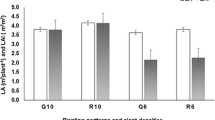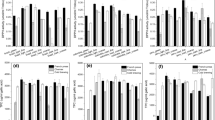Abstract
To identify chemical parameters that might be used as discriminators, pH, soluble solids, caffeine, trigonelline, total caffeoylquinic acids, 3-O-caffeoylquinic acid, 4-O-caffeoylquinic acid, 5-O-caffeoylquinic acid, total dicaffeoylquinic acids, 3,4-O-dicaffeoylquinic acid, 3,5-O-dicaffeoylquinic acid, 4,5-O-dicaffeoylquinic acid, total feruloylquinic acids, 3-O-feruloylquinic acid, and 5-O-feruloylquinic acid were measured in Arabica and Robusta coffees submitted to three roasting levels. It was found that the fraction of soluble solids increased with roasting level, being slightly higher in Robusta roasted coffee. The contents of caffeine did not vary significantly between roasting degrees within the Arabica and Robusta samples, respectively, revealing a considerable stability during browning. The contents of trigonelline in Arabica and Robusta coffee decreased significantly with browning intensification. Overall, the levels of chlorogenic acids remained higher in Robusta roasted coffee beans but decreased sharply with roast increase. With roasting intensification, the ratio of total caffeoylquinic acids, total dicaffeoylquinic acids, and total feruloylquinic acids varied markedly in both species, with the proportion of total caffeoylquinic acids and total feruloylquinic acids increasing significantly, whereas the opposite occurred with dicaffeoylquinic acids. One can conclude, through the application of a multivariate analysis, that these chemicals form four clusters, constituting caffeine, trigonelline, total dicaffeoylquinic acids, and total feruloylquinic acids a relevant group for T3 roasting level discrimination, in both coffee species. Additionally, detailing discriminators for roasting intensity in Arabica coffee might be caffeine, trigonelline, 3-O-caffeoylquinic acid, and 4-O-caffeoylquinic acid, whereas in Robusta roasted coffee are trigonelline, 3-O-caffeoylquinic acid, 4-O-caffeoylquinic acid, 5-O-caffeoylquinic acid, 3,4-O-dicaffeoylquinic acid, 3,5-O-dicaffeoylquinic acid, 4,5-O-dicaffeoylquinic acid, 3-O-feruloylquinic acid, and 5-O-feruloylquinic acid.





Similar content being viewed by others
Abbreviations
- CGA:
-
Chlorogenic acid
- CQAtotal :
-
Total caffeoylquinic acids
- 3-CQA:
-
3-O-caffeoylquinic acid
- 4-CQA:
-
4-O-caffeoylquinic acid
- 5-CQA:
-
5-O-caffeoylquinic acid
- diCQAtotal :
-
Total dicaffeoylquinic acid
- 3,4-diCQA:
-
3,4-O-dicaffeoylquinic acid
- 3,5-diCQA:
-
3,5-O-dicaffeoylquinic acid
- 4,5-diCQA:
-
4,5-O-dicaffeoylquinic acid
- FQAtotal :
-
Total feruloylquinic acid
- 3-FQA:
-
3-O-feruloylquinic acid
- 5-FQA:
-
5-O-feruloylquinic acid
- ICO:
-
International coffee organization
References
Leroy T, Ribeyre F, Bertrand B, Charmetant P, Dufour M, Montagnon C, Marraccini P, Pot D (2006) Braz J Plant Physiol 18:229–242
Mendonça LMVL, Pereira RGFA, Mendes ANG (2005) Ciências Tecnologia Alimentar 25:239–243
Nestlé (1991) Coffee. Documentation Centre, Corporate Affairs Department, Nestec Ltd, Vevey, Switzerland, pp 1–60
Silvarolla MB, Mazzafera P, Fazuoli LC (2004) Nature 429:826
Ferrão RG, Ferrão MAG, Fonseca AFA, Pacova BEV (2007) Melhoramento genético de Coffea canephora. In: Ferrão RG et al. (ed) Café Conilon, pp 121–173
Stennert A, Maier HG (1994) Z Lebensm Unters Forsch 199:198–200
Macrae R (1985) Nitrogenous components. In: Clarke RJ, Macrae R (eds) Coffee I: Chemistry. Elsevier Applied Science Publishers Co Ltd, London & New York, pp 115–152
Morais SAL, Aquino FJT, Nascimento PM, Nascimento EA, Chang R (2009) Quim Nova 32:327–331
Clifford MN, Staniforth PS (1977) A critical comparison of six spectrophotometric methods for measuring chlorogenic acids in green coffee beans. In: Huitième Colloque Scientifique International sur le Café. ASIC, Paris, pp 109–114
Viani R (1993) The composition of coffee. In: Caffeine, coffee, and health. S Garatin Raven Press Ltd, New York, pp 17–41
Clifford MN (1987) Chemical and physical aspects of green coffee products. In: Clifford MN, Wilson KC (eds) Coffee, botany, biochemistry and production of beans and beverage. Croom Helm & Methuen Inc, New York, pp 305–374
Clifford MN (1999) J Sci Food Agric 79:362–372
Correia MNG (1995) Manual da tecnologia do café. Cultivar, Associação dos Técnicos de Culturas Tropicais, Porto, p 117
Martin MJ, Pablos F, Bello MA, González AG (1997) Fresenius J Anal Chem 357:357–358
Stadler RH, Varga N, Hau J, Vera FA, Welti DH (2002) J Agric Food Chem 50:1192–1199
Instrução Normativa no 8 (2003) Regulamento técnico de identidade e de qualidade para a classificação do café beneficiado grão cru. Ministério de Estado da Agricultura, Pecuária e Abastecimento, Brasil
NP 1666 (1980) Café—Colheita de amostras de café verde em sacos. Direcção Geral de Qualidade, Lisboa
ISO 4072 (1982) Green coffee in bags-sampling. International Organization for Standardization
PSCB no 36/02 (2002) Code of practice: enhancement of coffee quality through prevention of mould formation. International Coffee Organization
AOAC (1996a) Coffee and tea. AOAC International—Association of Official Analytical Chemists, vol. 2, chapter 30
AOAC (1996b) Definition of terms and explanatory notes. AOAC International—Official methods of analysis, vol. 1, note 11
ISO 10095 (1992) Coffee. Determination of caffeine content. Method using high-performance liquid chromatography. International Organization for Standardization
Trugo LC, Macrae R (1984) Analyst 109:263–266
Farah A, De Paulis T, Trugo LC, Martin PR (2005) J Agric Food Chem 53:1505–1513
Neto JMM, Moita GC (1998) Quim Nova 21:467–469
Alvarenga N, Silva P, Rodriguez-Garcia J, Sousa I (2008) J Dairy Res 75:233–239
Chapman KW, Lawless HT, Boor KJ (2001) J Dairy Sci 84:12–20
Maeztu L, Andueza S, Ibañez C, de Peña MP, Bello J, Cid C (2001) J Agric Food Chem 49:4743–4747
Da Silva AFS, Minim VPR, Chaves JBP, Stringheta PC, Ribeiro MM (2004) Ciências Tecnologia Alimentar 24:468–472
Woodman JS (1985) Carboxylic acids. In: Clarke RJ, Macrae R (eds) Coffee I: Chemistry. Elsevier Applied Science Publishers Co Ltd, London and New York, pp 266–289
Siqueira HH, Abreu CMP (2006) Ciências Agrotecnológicas 30:112–117
Toci A, Farah A, Trugo LC (2006) Quim Nova 29:965–971
Daglia M, Cuzzoni MT, Dacarro C (1994) J Agric Food Chem 42:2273–2277
IC AB (2007) Revisão 15—Norma de qualidade recomendável e boas práticas de fabricação de cafés torrados em grão e cafés torrados moídos. Associação Brasileira da Indústria do Café, Brasil, pp 1–20
Alves ST, Dias RCE, Benassi MT, Scholz MBS (2006) Quim Nova 29:1164–1168
Mori EEM, Bragagnolo N, Morgano MA, Anjos VDA, Yotsuyanagi K, Faria EV, Iyomasa JM (2003) Food Food Ingred J Jpn 208:416–423
Clifford MN (1985) Chlorogenic acids. In: Clarke RJ, Macrae R (eds) Coffee I: Chemistry. Elsevier Applied Science Publishers Co Ltd, London and New York, pp 153–202
Ky LC, Louarn J, Dussert S, Guyot B, Hamon S, Noirot M (2001) Food Chem 75:223–230
Viani R (1986) Coffee. In: Ullmann's Encyclopedia of industrial chemistry, vol A7. VCH Verlagsgesellschaft, Weinheim, pp 315–339
Acknowledgments
The authors wish to thank Drs. Joel I. Fahl and Maria Luíza Carelli (IAC, Brazil) for the supply of seed material, Prof. Dr. Santos Oliveira (FCT/UNL) for his scientific suggestions and NOVADELTA for technical facilities.
Author information
Authors and Affiliations
Corresponding author
Rights and permissions
About this article
Cite this article
Bicho, N.C., Leitão, A.E., Ramalho, J.C. et al. Identification of chemical clusters discriminators of the roast degree in Arabica and Robusta coffee beans. Eur Food Res Technol 233, 303–311 (2011). https://doi.org/10.1007/s00217-011-1518-5
Received:
Revised:
Accepted:
Published:
Issue Date:
DOI: https://doi.org/10.1007/s00217-011-1518-5




